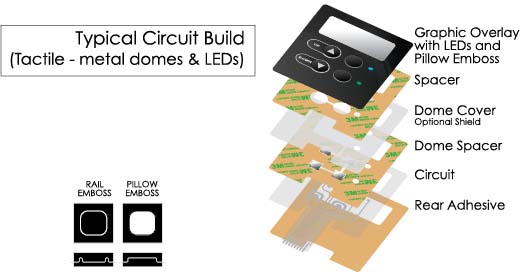Innovative Membrane Switch Solutions for Customized Control Panels
Comprehending Membrane Switches: The Secret to Resilient and Reliable Controls

What Are Membrane Layer Buttons?
Membrane layer buttons are a sophisticated solution in the realm of interface modern technology, incorporating functionality and design effortlessly. These gadgets act as a user interface between users and electronic systems, integrating several elements into a small style. Commonly created from versatile, slim layers of products, membrane layer switches are created to reply to touch, enabling individuals to engage with machinery and electronic devices efficiently.
The primary elements of a membrane switch include a printed circuit layer, visuals overlay, and a spacer layer that protects against unintentional activation. The graphic overlay can be personalized to reflect brand identification or customer choices, boosting aesthetic appeals while making sure functionality. Membrane buttons are generally made use of in various applications, consisting of clinical gadgets, consumer electronic devices, and commercial equipment, owing to their toughness and resistance to ecological elements such as moisture and dirt.
Among the crucial benefits of membrane buttons is their capacity to endure deterioration, making them suitable for high-traffic atmospheres. Additionally, they are light-weight and need minimal room, permitting cutting-edge styles in item advancement. Overall, membrane layer switches stand for a reliable and useful selection for contemporary electronic interfaces, marrying technology with user-centric style concepts.
Exactly How Membrane Layer Switches Over Work
The operation of membrane switches over hinges on a basic yet effective system that converts customer input into electronic signals. When a customer presses the switch, the top layer flaws, allowing a conductive element in the circuit layer to make contact with a matching conductive pad on the bottom of the graphic overlay.
The style of membrane layer buttons can differ, but they usually incorporate domes or tactile components to provide feedback to the individual, boosting the general experience - membrane switch. The products made use of in membrane layer switches, such as polyester or polycarbonate, contribute to their resilience and resistance to environmental aspects, consisting of wetness and dirt. Furthermore, the printed circuits are generally encapsulated, which safeguards them from wear and tear in time.
Benefits of Membrane Switches

Additionally, membrane switches are recognized for their toughness. Created from durable materials, they are resistant to dust, moisture, and physical wear, which substantially prolongs their life-span contrasted to typical mechanical buttons. This durability makes them particularly suitable for high-traffic environments and applications requiring longevity.
Another significant advantage is the convenience of cleansing and upkeep. The smooth surface area of membrane switches decreases dirt buildup and is usually resistant to spills, making them ideal for setups that call for regular sanitization.
Additionally, membrane switches offer a structured account, causing a thinner style that can be integrated right into numerous gadgets without adding mass. This attribute not only enhances the visual charm however also adds to a much more ergonomic product design.
Applications of Membrane Layer Switches
Easy to use and flexible, membrane layer buttons find applications across a large range of markets, including clinical gadgets, consumer electronic devices, and industrial tools. In the medical area, these buttons are integral to tools such as diagnostic tools, individual monitoring systems, and mixture pumps, where reliability and convenience of cleaning are critical. Their capability to endure rough atmospheres and keep capability makes them perfect for such applications.

In consumer electronics, membrane layer switches are utilized in items like microwaves, washing devices, and remotes - membrane switch. Their streamlined layout permits user-friendly interface, boosting the overall user experience while supplying resilience and resistance to tear and put on
Industrial devices likewise gains from membrane switches, especially in control panels for equipment and automation systems. These buttons supply protection against dust and wetness, making certain consistent performance in difficult atmospheres. Continue Their customizable features allow producers to tailor them to particular operational requirements, improving effectiveness and functionality.
Choosing the Right Membrane Switch
When selecting a membrane switch, it is vital to consider various factors that affect efficiency and viability for details applications. The main considerations include environmental conditions, responsive responses, toughness, and style specs.
First, evaluate the operating atmosphere; switches exposed to dampness, chemicals, or severe temperatures require specific products to ensure long life and capability. Next, assess the demand for responsive comments. Depending on customer interaction, some applications may take advantage of a tactile response to validate activation, while others may favor a non-tactile style Find Out More for aesthetic factors.
Toughness is one more crucial factor; membrane layer switches need to be made to stand up to frequent usage, impacts, and abrasion. Make certain the chosen button can endure the anticipated lifecycle, specifically in high-usage situations.

Conclusion
In conclusion, membrane layer switches over function as necessary elements in the design of trustworthy and resilient control systems throughout different industries. Their portable design, incorporated with robust construction and adjustable features, boosts user communication while guaranteeing longevity popular environments. The adaptability of membrane changes permits customized solutions that satisfy specific functional needs, strengthening their value in contemporary innovation. As industries proceed to advance, the significance of incorporating efficient membrane layer switch options can not be overemphasized.
Membrane switches represent a critical element of modern-day interface layout, mixing functionality with resilience in different applications.Membrane layer buttons are an innovative remedy in the realm of user interface innovation, integrating performance and style effortlessly. Commonly created from adaptable, slim layers of products, membrane layer buttons are created to respond to touch, visit this site allowing individuals to communicate with machinery and electronic devices effectively.
The layout of membrane layer buttons can differ, however they typically integrate domes or tactile elements to give responses to the customer, improving the general experience.In conclusion, membrane switches over offer as necessary elements in the design of durable and reliable control systems throughout different industries.